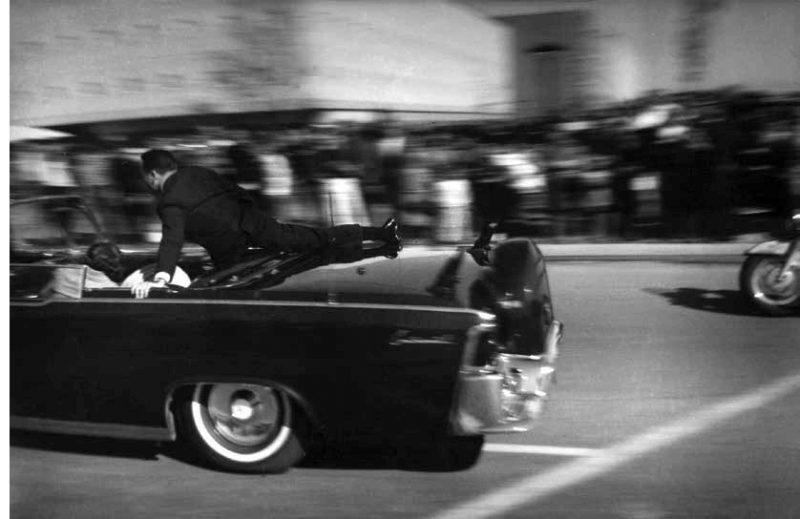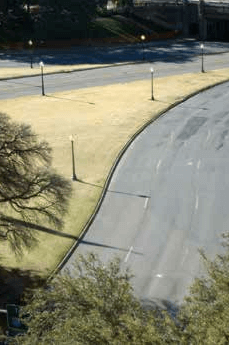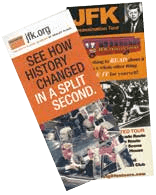Issue:

THE HALF CENTURY MARK OF THE ASSASSINATION OF JFK DRAWS OUR CORRESPONDENT INTO VISITING THE SCENE OF THE CRIME
JFK still haunts Dallas 50 years on
by Mark Schreiber
Every American over a certain age has vivid recollections of November 22, 1963, when the shocking news broke of President John F. Kennedy’s shooting.
In my case, I was drowsing in Mr. Thomas’ fifth period English class at high school in Fayetteville, North Carolina. Just before 2:00 p.m., I was rudely awakened by noisy static from the classroom’s PA, followed by the voice of an excited radio announcer relaying news of the shooting to the room full of horror stricken 11th graders.
I spent the rest of that dreadful weekend at home, glued to the black-and-white Zenith TV in the family den. Sunday afternoon, the networks delivered another shock, as I witnessed live from the basement of the Dallas Police Department the telecast of the fatal shooting of Lee Harvey Oswald, JFK’s accused killer, by Jack Ruby.
Fast forward to December 2012. I had been to the graves of JFK and his first lady (who died in May 1994) at Arlington Cemetery outside Washington D.C. The run up to the 50th anniversary seemed like a good time to visit the place where he met his untimely death.
Fortunately, I was able to procure the services of an expert native guide. FCCJ member Glenn Davis, a home grown Texan and assassination conspiracy buff who now resides in a suburb of Houston, accompanied me for the duration. In addition to teaching me how to use the right lavatory (“The door with the horseshoes pointing up is the men’s room”), he led me to numerous spots off the beaten track, supplementing his historical monologue with a cornucopia of theories regarding the “real” perpetrators of the JFK slaying.
One place we visited was Parkland Memorial Hospital, where Dr. Kemp Clark, Parkland’s director of neurological surgery, pronounced Kennedy dead of a gunshot wound to the head.
The actual spot where JFK died, Trauma Room 1, was demolished in the 1970s. But in the hospital’s administrative corridor one can view a five meter long display panel containing the American and Texas state flags, the U.S. presidential seal and portraits of Kennedy and his successor Lyndon Baines Johnson. At the bottom, a bronze plaque carries the text of an office memo randum from the hospital’s administrator, circulated five days later, which points out that Parkland had briefly become “the temporary seat of the government of the United States” and “the center of attention of the world.”
“Our pride is not that we were swept up by the whirlwind of tragic history, but that when we were, we were not found wanting,” it concludes.
With the 50th anniversary of JFK’s death approaching, it’s a safe bet that the local and national media will not be found wanting in serving up reminders of the man and his times.
With the 50th anniversary of JFK’s death approaching, it’s a safe bet that the local and national media will not be found wanting in serving up reminders of the man and his times.
Barring any earth shattering revelations that can be proved beyond reasonable doubt, however, the often raucous debates over the events that transpired in Dallas in 1963 are almost certainly destined to enter their sixth decade with no solution in sight.
Unlike the glossy waxed corridors of Parkland Hospital, Elm Street in Dealey Plaza projects a somewhat ghoulish aura due perhaps to the two white letter Xs painted conspicuously in the center lane. They mark the approximate spots of the limousine in which JFK and Texas governor John Connelly were seated, en route to a luncheon at the nearby Trade Mart, when they were struck by bullets. Connelly survived his wounds.
At the time of my visit, Dealey Plaza, a Depressionera works project completed in 1940 (and finally designated a National Historic Landmark in 1993), was undergoing a major refurbishing.
Barely changed from 1963 newsreels (except for the noticeably higher surrounding trees), are the spots made famous in the news reports, books and documentary films: the infamous “grassy knoll” a term credited to UPI’s Merrimam Smith; the picket fence; the triple underpass; the storm drain; the railway yard; and the concrete pedestal from which local businessman Abraham Zapruder, using his 8mm Bell & Howell home movie camera, filmed the harrowing 26.6 second sequence that climaxed in frame 313, in which a spray of blood and brain matter emanates from the president’s head as his wife reacts in horror.

photo by MARK SCHREIBER

THE DEBATES OVER THE EVENTS THAT TRANSPIRED IN DALLAS IN 1963 ARE ALMOST CERTAINLY DESTINED TO ENTER THEIR SIXTH DECADE WITH NO SOLUTION IN SIGHT
Bearing the smirk of a knowledgeable skeptic, Glenn escorted me to the Sixth Floor Museum inside the former Texas School Book Depository at the corner of Elm and Houston Streets. (We both qualified for a $2 senior discount; regular admittance charges are $16 for adults and $13 for minors age 6-18.)
Museum visitors can watch newsreels and view various artifacts on display, including an old teletype machine whose roll of paper contains a printout of UPI’s original news flash, filed at 1:34 pm East- ern Standard Time, that reads “Three shots were fired at President Kennedy’s motorcade today in downtown Dallas, Texas.”
The museum’s showpiece is the “sniper’s nest” by the southeast corner window, which was reconstructed based on photos of the original crime scene boxes of text books that Lee Harvey Oswald allegedly stacked for concealment before firing his Italian made Carcano M91/38 carbine at the president’s limousine. Unfortunately the corner is encased in protective glass, preventing visitors from approaching the window to view the street below. To circumvent this, we walked up to the seventh floor, whose southeast window gave an unobstructed and almost identical view of what a shooter one floor below would have seen.
The museum also operates a gift shop on the ground floor. For more exotic shopping, CDs and tabloid newspapers serving up assassination conspiracy theories are offered by the veteran hawkers who inhabit the sidewalk at the intersection of Houston and Elm Streets. One declined to be interviewed for this article, complaining that reporters in the past “never ran what I had told them anyway.”
Still in business in the nearby suburb of Oak Cliff is the Texas Theater, where Oswald, having allegedly fled the shootings of JFK and police officer J.D. Tippit, was arrested. Glenn also led me on a walking tour of the downtown area, to the JFK Memorial Plaza on Commerce Street. We retraced portions of the 1963 motorcade route past the Nieman Marcus department store to the old Municipal Building, where strip club owner Jack Ruby fatally shot Oswald.
JFK’s assassination, I was to learn years later, also holds vivid memories for TV viewers in Japan. By coincidence, the commencement of live broadcasts from the U.S. via the Telstar communications satellite had been scheduled for Saturday, November 23, 1963 (Japan time). When viewers switched on their sets that morning, the first live transmissions they saw were news bulletins reporting JFK’s death.
Influenced by a huge and still growing body of literature and Oliver Stone’s 1991 controversial movie JFK, millions of Americans still hold doubts over the government’s explanation of the events that occurred in 1963, as affirmed by periodic surveys. For this writer, a three day visit to Dallas was more than enough to rekindle painful memories of JFK’s untimely death, but provided no new revelations as to his killer’s identity.
As a teen, Mark Schreiber once wrote to JFK and was thrilled to get a response. He currently writes the “Big in Japan” and “Bilingual” columns for The Japan Times

